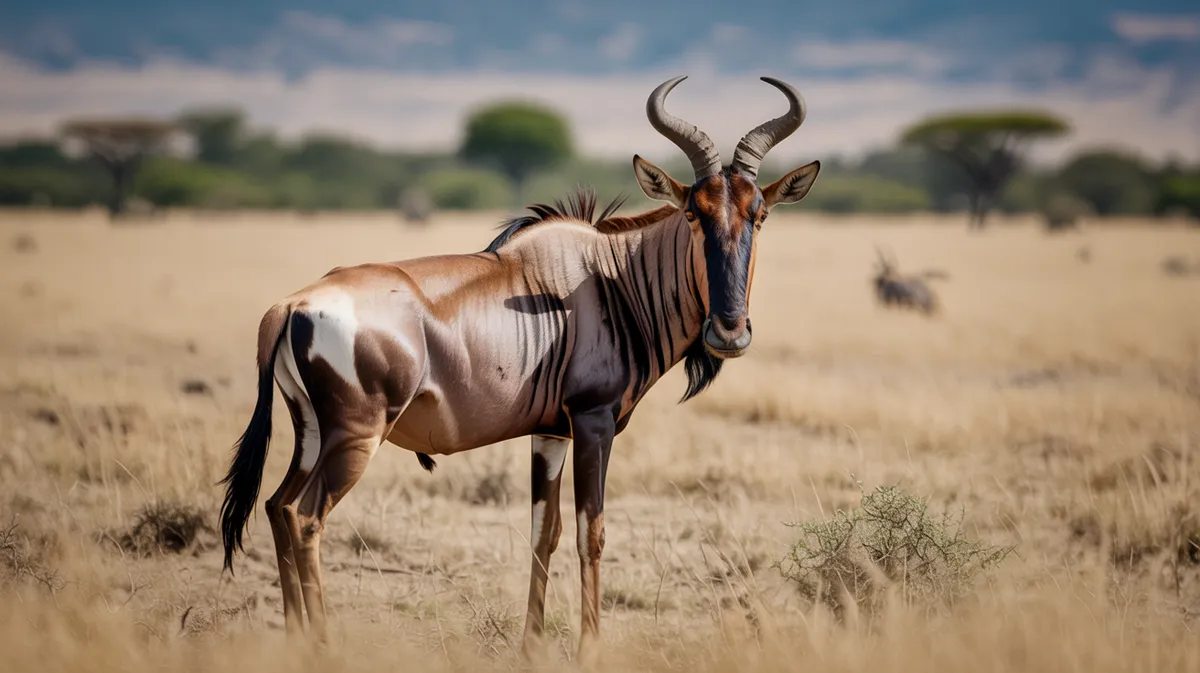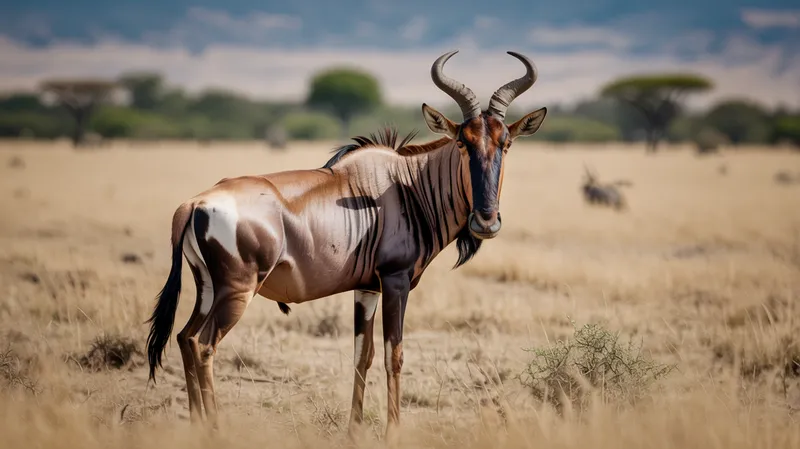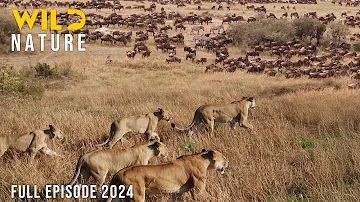
Hartebeest
Alcelaphus buselaphus

Meet the Hartebeest
The hartebeest is a large African antelope recognized by its elongated forehead, oddly shaped horns, and sloping back. Adapted for life on open plains and savannas, the hartebeest is a swift runner capable of reaching speeds up to 70 km/h to evade predators. They are social animals, typically forming herds that may number from a few individuals to several hundred. Hartebeests primarily graze on grasses and play an important role in maintaining the ecological balance of their habitats.
Classification
Mammal
Habitat
Savanna and grassland
Diet
Herbivore
Lifespan
12–15 years
Conservation
Least Concern
Weight
100–200 kg
📖Fascinating Facts
Fast Runners
Hartebeests can reach speeds of up to 70 km/h, making them one of Africa's fastest antelopes.
Unique Horns
Both male and female hartebeests have distinctive, lyre-shaped horns that can grow up to 70 cm long.
Vigilant Grazers
Hartebeests often take turns watching for predators while the herd grazes, providing safety in numbers.
📋Detailed Description
The hartebeest (Alcelaphus buselaphus) is a robust, large-bodied African antelope distinguished by its elongated, narrow face, sharply sloping back, and prominent shoulder hump formed by elongated dorsal vertebrae. Adults stand 1.1–1.4 meters at the shoulder and measure 200–250 cm in head-body length, with weights ranging from 100 to 200 kg depending on sex and subspecies. Both males and females possess distinctive, lyre-shaped horns, which can reach 45–70 cm in length; male horns are typically heavier and more robust, while females' are slender. The short, glossy coat varies in color across subspecies, from pale sandy hues to deep reddish-brown or chocolate, often with contrasting black markings on the legs and face. Hartebeest have long, muscular legs adapted for speed and endurance, enabling them to sustain high-speed gallops (up to 70 km/h) over open grasslands. Their large, mobile ears and wide-set eyes provide excellent hearing and vision, crucial for predator detection. Socially, hartebeest form complex herds that may include bachelor groups, territorial males, and mixed groups of females with calves. They are primarily diurnal, grazing during the cooler hours and resting in shade during midday heat. As obligate grazers, they play a vital role in grassland ecology by influencing plant community structure and nutrient cycling.
💡 Did you know?
The hartebeest's scientific name, Alcelaphus buselaphus, once referred to multiple subspecies found across Africa, but some are now extinct or critically endangered.
🔬Research & Sources
Wikipedia Summary
The hartebeest, also known as kongoni or kaama, is an African antelope. It is the only member of the genus Alcelaphus. Eight subspecies have been described, including two sometimes considered to be independent species. A large antelope, the hartebeest stands just over 1 m at the shoulder, and has a typical head-and-body length of 200 to 250 cm. The weight ranges from 100 to 200 kg. It has a particularly elongated forehead and oddly-shaped horns, a short neck, and pointed ears. Its legs, which often have black markings, are unusually long. The coat is generally short and shiny. Coat colour varies by the subspecies, from the sandy brown of the western hartebeest to the chocolate brown of the Swayne's hartebeest. Both sexes of all subspecies have horns, with those of females being more slender. Horns can reach lengths of 45–70 cm (18–28 in). Apart from its long face, the large chest and the sharply sloping back differentiate the hartebeest from other antelopes. A conspicuous hump over the shoulders is due to the long dorsal processes of the vertebrae in this region.
Last Modified: 5/25/2025
🎭Behavior & Social Structure
Hartebeest are highly social, with herd structures varying by region and season. Typical herds consist of 20–300 individuals, though aggregations can swell to over 1,000 during migrations or in response to resource availability. Territorial adult males defend discrete areas (often 31–200 hectares), marked by dung piles and scent from preorbital glands, and actively exclude rival males. Bachelor males form separate groups, while females and their offspring move in loosely associated herds. Feeding occurs primarily in the early morning and late afternoon, focusing on medium to tall grasses; hartebeest are selective grazers, often preferring recently burned or regenerating grass. They are vigilant, relying on their keen senses to detect predators such as lions, hyenas, and wild dogs. When alarmed, they emit snorts and may stamp their feet before fleeing in a zigzag pattern. Resting and ruminating take place during the hottest part of the day, often in shaded areas.
👶Reproduction & Life Cycle
Hartebeest are polygynous, with dominant territorial males mating with multiple females whose home ranges overlap their territories. Breeding can occur year-round in equatorial regions but is typically seasonal elsewhere, often peaking after the rainy season when food is abundant. The gestation period lasts approximately 8 months (240 days), after which a single calf (rarely twins) is born. Calving is usually synchronized within herds to overwhelm predators. Newborn calves are precocial, able to stand and follow their mothers within minutes to hours. Mothers hide their calves in tall grass for the first week, visiting them for nursing several times a day. Weaning occurs at 4–8 months, and sexual maturity is reached at 1.5–2 years for females and 2–3 years for males. Male dispersal reduces inbreeding and promotes genetic diversity.
🛡️Adaptations & Survival
Hartebeest exhibit several adaptations for survival in open savannas. Their elongated skull and specialized dentition (high-crowned molars) allow efficient cropping and grinding of tough grasses. The sloping back and powerful forequarters enhance running efficiency and maneuverability, aiding escape from predators. Their large, mobile ears and wide field of vision facilitate early predator detection. Physiologically, hartebeest can tolerate high temperatures and water scarcity, obtaining moisture from their diet and reducing activity during the hottest periods. Socially, their herd structure provides collective vigilance and predator dilution. Synchronized calving and cryptic coloration of calves further reduce predation risk.
📚Research Sources
🎨Cultural Significance
Hartebeest have played a role in African cultures for millennia, depicted in prehistoric rock art and folklore. Their meat and hides have been traditionally used by local communities, and their horns are sometimes fashioned into tools or ornaments. In some regions, the hartebeest symbolizes agility and vigilance. The extinct Bubal hartebeest was known to ancient Egyptians and may have been domesticated or used in religious ceremonies. Today, hartebeest are valued for their ecological role and as game animals in sustainable hunting programs.
🔬Recent Research & Discoveries
Recent research has focused on the genetic diversity and phylogeography of hartebeest subspecies, revealing deep evolutionary splits and supporting the potential recognition of some as distinct species. Studies on their grazing ecology have highlighted their importance in maintaining grassland heterogeneity and supporting biodiversity. Ongoing research investigates the impacts of habitat fragmentation and climate change on hartebeest movements and population viability. Conservation genetics is being used to inform management of isolated and endangered populations, such as Swayne's hartebeest in Ethiopia.
🎥Wildlife Videos

Wild Animals in Nature - Hartebeest
This series is a group of short videos that allow you to simply spend a few on a short wildlife safari with us. We took old footage ...
The All Around Project

DANGER Nearby - Hartebeest on Alert | A Short Wildlife Safari
Take a break from the daily grind for your mental health and join us as we explore the beautiful world of wild animals. Here, we get ...
The All Around Project

WILD SERENGETI | Battle for Survival in Predator Territory | Animal documentary
Step into the untamed world of the Serengeti, a sprawling savanna where every moment is a fight for survival. In this gripping ...
WILD NATURE - Nature animal documentary

Wildlife - The Fascinating World of Wild Animals | Full Series | Free Documentary Nature
Wildlife - The Fascinating World of Wild Animals | Wildlife Documentary Watch 'Ocean Stories - Full Series' here: ...
Free Documentary - Nature

Hartebeest (Alcelaphus buselaphus) | animal deep life
Hartebeest (Alcelaphus buselaphus) | animal deep life #heartbeest #wildlife #animals #deeplifestyle #animalife The hartebeest ...
animal deep life

The Baltic | Survival in a Pristine Ecosystem | Animal documentary
Welcome to "The Baltic | Survival in a Pristine Ecosystem", a captivating wildlife documentary that transports you to the serene yet ...
WILD NATURE - Nature animal documentary
🌍Habitat Information
The Hartebeest typically inhabits Savanna and grassland environments. Hartebeests have adapted to their environments with specialized features and behaviors.
Primary Habitat:
Savanna and grassland
More detailed habitat information will be available soon.
🛡️Conservation Status
The Hartebeest is currently classified as Least Concern. Conservation efforts are crucial for preserving this species for future generations.
Common Threats:
- 🏠Habitat loss and fragmentation
- 🌡️Climate change impacts
- 🎯Hunting and poaching
- 🏭Human-wildlife conflict
⚠️Threats & Conservation Challenges
While the hartebeest as a species is classified as Least Concern by the IUCN, several subspecies face significant threats. Habitat loss and fragmentation due to agriculture, livestock overgrazing, and human settlement are major concerns, particularly for the critically endangered Swayne's and Tora hartebeest. Poaching for meat and horns, competition with domestic livestock, and disease transmission (notably rinderpest in the past) have also contributed to population declines. Some subspecies, such as the Bubal hartebeest (A. b. buselaphus), are already extinct. Population trends are stable or increasing in protected areas but declining elsewhere, highlighting the need for continued conservation action.
🔬Scientific Classification
Scientific Name
Alcelaphus buselaphus
Classification Hierarchy
🔍 About Taxonomic Classification
Taxonomic classification is a hierarchical system used by scientists to classify and organize living organisms based on shared characteristics and evolutionary relationships.
The system moves from broad categories (Kingdom) to increasingly specific ones, with each animal's scientific name typically consisting of its Genus and species.
📝Community Notes
Share your observations and insights about the Hartebeest with our community of wildlife enthusiasts.
Join Our Community
Sign in to share your observations and connect with fellow wildlife enthusiasts.
Sign In to ContributeNo community notes yet
Be the first to share your observations about the Hartebeest!
Explore Hartebeest
Select a tab above to learn more about this amazing animal.
📸Photo Gallery
No photos available for this animal yet.
🌟Discover More Wildlife
Continue your journey of discovery with more fascinating animals from our database
